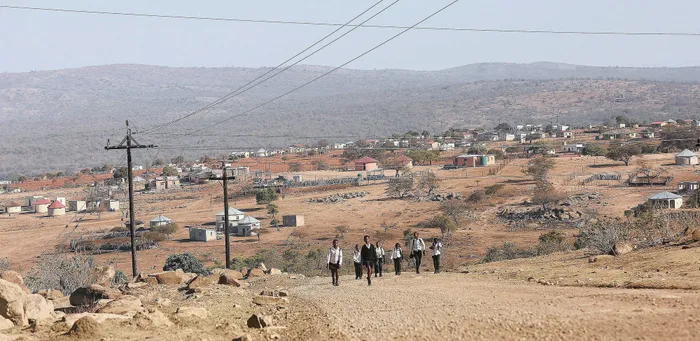Millions of South African children walk to school daily as Transport Month reveals inequalities

As South Africa marks Transport Month, data shows nearly two-thirds of learners walk to school, while many households face high transport costs.
Image: Zanele Zulu / Independent Newspapers Archives
October marks Transport Month in South Africa, a time to reflect on the progress and challenges in building a transport system that works for everyone.
This year’s theme, “Implementing an integrated, sustainable, and safe transport system that promotes inclusive economic growth, job retention and creation, and social development,” highlights how transport shapes everyday life - from children walking to school to workers making their way to jobs - revealing both the strides made and the inequalities that persist in access and affordability.
The figures reveal the everyday realities for millions: children covering long distances to get to school safely, households managing high transport costs and workers balancing affordability with the need to reach their jobs.
Recent data from the General Household Survey (GHS) 2024 shows that land transport remains the primary means of travel for most South Africans. Nearly two-thirds (61.1%) of learners walk to school, while 14.8% rely on transport arranged by parents, 10.1% travel by private car, 7.1% use taxis, and 1.5% take the bus. For workers, fewer than a quarter (22,8%) walk to work, with more than half relying on motorised transport such as private cars (25.9%), taxis (24.3%), buses (3.6%), and lift clubs (2.6%).
The 2020 National Household Travel Survey (NHTS) sheds light on the cost of these journeys. Of the 6.3 million households with at least one person using public transport weekly to get to work, nearly three-quarters (74.5%) spent R300 or more on transport. For learners travelling to educational institutions, 26,9% of households spent between R500 and R1 000, with others spending R301 - R500 (24.5%) or R201–R300 (15%).
Transport’s financial impact on households is significant. The Income and Expenditure Survey (IES) 2022/23 ranked it as the third-largest contributor to household consumption expenditure, accounting for 15.3% or an estimated R467 billion. On average, South African households spent around R21 930 on transport during the survey year, with the highest provincial averages recorded in the Western Cape (R33 487), Gauteng (R29 333), and Mpumalanga (R21 964).
Transport also plays a key role in employment. The Quarterly Labour Force Survey (QLFS) for Quarter 2 of 2025 (April - June) shows that about 1.12 million people were employed in the transport sector, an increase of 51 000 compared to the same period last year. Of these, 732 000 worked in the formal sector and 384 000 in the informal sector.
Despite growth in employment, the sector’s overall economic performance slowed. The Gross Domestic Product (GDP) report for the second quarter of 2025 showed that the transport, storage, and communication industry contracted by 0.8%, mainly due to reduced activity in land transport and transport support services.
While transport connects people and drives economic activity, it also presents serious risks. Road crashes and injuries remain a daily reality in South Africa and around the world. Recognising this, road safety was included in the global Sustainable Development Goals (SDGs) in 2015. Two goals specifically address road safety: Goal 3, which aims to halve the number of global deaths and injuries from road traffic accidents by 2020, and Goal 11, which seeks to provide access to safe, affordable, and sustainable transport systems for all by 2030.
According to the Road Traffic Management Corporation (RTMC) State of Road Safety 2023 report, globally, occupants of four-wheel vehicles account for 30% of road fatalities, with no distinction between drivers and passengers. Pedestrians make up 23%, followed by users of powered two- and three-wheelers at 21%, and cyclists at 6%. The remaining 20% of fatalities involve occupants of large passenger vehicles, heavy goods vehicles, and other or unidentified users.
In South Africa, the Mortality and Causes of Death 2022 report recorded 64 575 non-natural deaths, up slightly from 60 999 in 2021. The 20 - 24 age group was most affected, with high proportions also seen among those aged 25 - 29 (46,4%), 15 - 19 (46,0%), 5 - 9 (36,3%), 30 - 34 (35.7%), and 10–14 (34.6%). Transport accidents were the third most common cause of non-natural deaths, accounting for 7.1% of such deaths and 0.9% of all deaths recorded in 2022.
Transport Month serves as a reminder that mobility in South Africa is shaped by inequality. For many, walking long distances to school or relying on taxis is not a choice but a reflection of limited options and affordability constraints. While cars remain out of reach for most households, access to safe and reliable transport continues to mirror the country’s broader social and economic divides.
As South Africa reflects on progress this Transport Month, the challenge remains to make movement equitable, ensuring everyone - from children walking to school to workers commuting daily - can travel with dignity and opportunity.